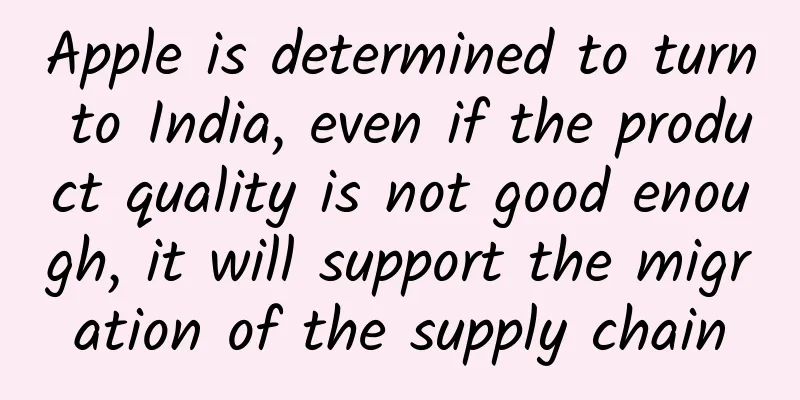Apple is determined to turn to India, even if the product quality is not good enough, it will support the migration of the supply chain

|
Since the beginning of the millennium, China has become the "world factory" leading the global industrial progress with its sufficient and highly qualified labor force, rich supply of raw materials and open economic policies. From clothing, home appliances, digital electronics to automobiles, global giants in major fields have established complete and long industrial supply chains in China. Among many international giants, Apple is one of the most active brands in laying out its supply chain in China. For many years, Apple has been a model in terms of compliance with policies, promotion of employment opportunities, and even environmental protection. According to a list provided by Apple officials, 51 of the company's top 200 suppliers in 2020 are from mainland China and Hong Kong, China, the highest number in the world. The reason why Apple regards China as its product production center is not only for cost considerations, but more importantly because of the stable production environment in China that is unrivaled in the world. However, as a large company with business all over the world, in order to share risks, Apple will naturally consider expanding its supply chain, and now they have set their sights on China's neighbor: India. Recently, Apple announced that it will produce iPhone 12 and iPhone 13 in India, and Pegatron and Foxconn will still be responsible for the assembly and production. Although the iPhones currently produced in India will not be exported, Apple's move has shown that they hope to reduce their dependence on the Chinese supply chain. As the world's most populous country, India is already the world's second largest mobile phone market and still has huge development potential. According to IDC statistics, four of the five brands with the highest market share in India in 2021 are from China, namely Xiaomi, realme, vivo and OPPO, while Apple's market share is only 4.4%. Not only sales, Apple's production in India is also not going smoothly. As early as 2015, Apple tried to establish a supply chain in India. However, after years of planning, there are more negative news surrounding Apple's Indian supply chain: in 2020, Wistron, a Taiwanese company that built a factory in the local area, was smashed and smashed by workers in protest due to arrears of payment to the company. In January this year, Foxconn's mobile phone assembly plant in southern India also suffered a collective food poisoning incident among employees. At present, Apple only produces four mobile phones in India, namely iPhone SE (2017), iPhone 11, iPhone 12, and iPhone 13, as well as some PD chargers, and a considerable number of them are only sold in India. This is enough to show that the quality of Indian manufacturing is far from fully meeting Apple's requirements. In this case, why does Apple still want to make a full effort in the Indian market? From a market perspective, Apple's smaller market share in India is largely due to its higher prices, but from a revenue and profit perspective, Apple is still in a relatively high position. According to statistics, Apple's revenue in India in the fourth quarter of last year was $2.09 billion, surpassing Samsung's $2 billion. This year, Apple launched a cheaper new iPhone SE, and its previous price reduction measures for iPhone 12 in India have also achieved certain results. Therefore, it is not ruled out that Apple will offer discounts on the Indian-made iPhone 13 to win more market share for it. From the perspective of production continuity, Apple also has enough reasons to continue betting on India. India has introduced a series of policies to attract mobile phone manufacturers to build factories. As early as 2014, Indian Prime Minister Modi proposed the goal of making India a "global PC and mobile phone manufacturing center." To this end, the Indian government imposes a 10% tariff and 35%-40% VAT on the import of complete mobile phones, while the import tax rate for parts and components is greatly reduced or even zero. Mobile phones produced in India only need to pay 12% VAT. This has attracted many mobile phone brands including vivo, Xiaomi, and Samsung to build factories in India, helping India quickly acquire much-needed technological accumulation. The subtle thing is that these Chinese and Korean manufacturers have planted trees before, and now Apple is likely to come over and enjoy the shade. In addition, the Indian government approved a $10 billion incentive plan at the end of last year to attract large semiconductor manufacturers to build semiconductor production bases locally. It has already attracted companies including Foxconn's parent company Hon Hai, and Apple also has the opportunity to take advantage of this opportunity. With Apple's current strength and capital, it can at least maintain its support for the Indian supply chain for a longer period of time and with higher investment. Once successful, its bargaining power and economic effects will also be greatly improved. Therefore, Apple's determination to establish a stable supply chain in India should never be underestimated. Overall, compared to the quality of Indian manufacturing, the issue we need to worry about is whether companies like Apple are taking the lead in moving to India. As the industry leader, Apple has a strong leading role, and it is hard to say that this approach will not cause other companies to follow suit. Today it is mobile phones and computers, and tomorrow it may be the turn of new energy vehicles. If this continues, the impact of the loss of manufacturing on the country will be difficult to ignore. Apple's transfer of production capacity to India should definitely attract China's attention. It must be admitted that the current electronic product assembly is still a labor-intensive industry, and as India's population surpasses China, my country's labor cost advantage will only become lower and lower, and the outflow of production capacity will be inevitable in the long run. Therefore, it is necessary for us to vigorously promote the popularization of industrial robots and artificial intelligence in the manufacturing industry, so as to win with higher efficiency. More importantly, Chinese brands need to strengthen themselves. The plummeting performance of OFILM after being kicked out of Apple's supply chain has proved that relying on a single customer and a single business is not a long-term solution. Therefore, other "Apple supply chain" companies must also take this as a warning and expand new businesses and fields while the wind brought by Apple is still there, so as to prepare for the wind to stop. I also hope that other domestic mobile phone manufacturers can work hard to strengthen themselves and continuously launch better products. As a winner of Toutiao's Qingyun Plan and Baijiahao's Bai+ Plan, the 2019 Baidu Digital Author of the Year, the Baijiahao's Most Popular Author in the Technology Field, the 2019 Sogou Technology and Culture Author, and the 2021 Baijiahao Quarterly Influential Creator, he has won many awards, including the 2013 Sohu Best Industry Media Person, the 2015 China New Media Entrepreneurship Competition Beijing Third Place, the 2015 Guangmang Experience Award, the 2015 China New Media Entrepreneurship Competition Finals Third Place, and the 2018 Baidu Dynamic Annual Powerful Celebrity. |
<<: Qualcomm + Huawei: Snapdragon 810 reaches 410Mbps!
Recommend
Revealing the alternative method of using Apple loopholes for promotion
Have you ever been annoyed by those annoying bann...
How to make 100,000 RMB a month with Douyin local food accounts
I think many people thought when they were young ...
Learn how to optimize information flow ads in one article! Applicable to all industries
Many friends asked: I have been working as an opt...
Why do cacti have thorns?
When you think of cactus, what comes to mind firs...
The largest Apple delisting incident in 2018: more than 40,000 apps were removed from the Chinese region in a single day!
Today (June 27), the App Store showed a large-sca...
How can a newbie become a Taobao customer? How does Taobao Affiliate do promotion?
With the impact of the epidemic, all walks of lif...
The impact of anemia may be greater than you think! How to self-diagnose whether you have anemia?
Author: Han Bing, Chief Physician, Peking Union M...
Food Safety | Are you drinking coffee correctly? Here is the correct way to open it
Brewing a cup of coffee in the morning to refresh...
General Bradley's 2021 Trading Strategy Lecture
General Bradley's 2021 Trading Strategy Lectur...
Teacher Zhenhong's Ultimate Course: How I Make Money from Stock Trading, Make Stock Trading a Money-Making Skill
Teacher Zhenhong's Ultimate Course: How I Mak...
How to monetize short videos in 2020?
A netizen on Zhihu asked: "With zero foundat...
Yotta《Learning AE from Scratch》
Course Catalog ├──Learn AE from Scratch (Part 1)|...
Aren't plants afraid of fire? How did they learn to "add fuel to the fire" and "take advantage of the fire"?
In our impression, fires seem to mean a catastrop...
Chinese scientists have made a breakthrough! Solar cells that look like paper are here
Ultra-thin, bendable solar cells are here! Chines...
Who is healthier, people who have nocturia or those who don’t? How many times is normal to urinate at night? The answer is…
When I was young, I could sleep till dawn. But I ...









